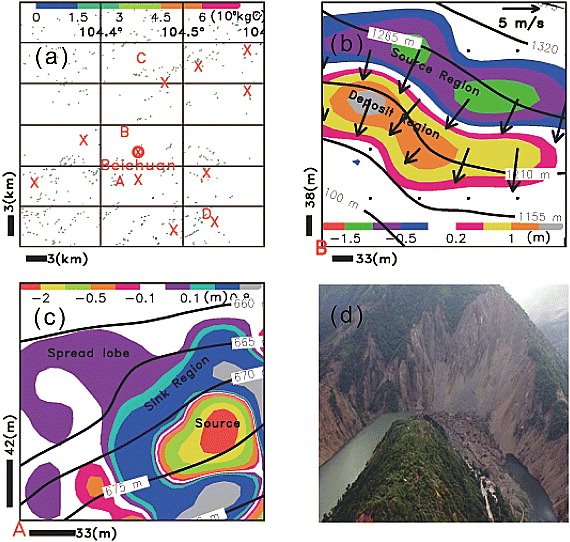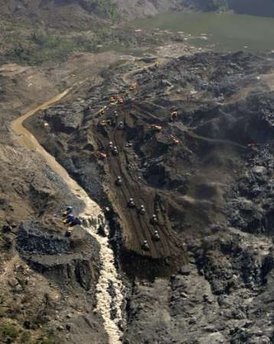6 March 2009
The role of landslides in global warming
Posted by Dave Petley
A rather extraordinary paper has just been published in Geophysical Research Letters about landslides triggered by the Wenchuan (Sichuan) earthquake. Why is it extraordinary – well, let me quote from the abstract. The paper suggests that the landslides caused destruction of vegetation such that “the cumulative CO2 release to the atmosphere over the coming decades is comparable to that caused by hurricane Katrina 2005 (~105 Tg) and equivalent to ~2% of current annual carbon emissions from global fossil fuel combustion.”
Wow! In case you are struggling to decode the above, this suggests that the landslides triggered by the earthquake caused a massive loss of vegetation that will now decay. In decaying it will release CO2, which will add to the effects of global warming. This is a pretty interesting result – and it has already been picked up by the mainstream media.
So, how do the authors reach these remarkable conclusions, and are they valid? Well, I am afraid that I have some serious doubts about this study, which seem to be based on some misunderstandings of earthquake-induced landslides. Lets base the analysis on Fig 2 of the paper, reproduced below, in which the authors highlight one of the landslides that blocked the valley on the river upstream of Beichuan:

So why do I object so strongly to the paper? Well first, the use of terminology is inexcusably weak. For example, the authors describe the landslides thus (referring to Fig 2a): ” (a) Living carbon scars left by mudslides, which indicates the geographical locations of the landslides for this region.” NO – these are not mudslides – these are clearly shallow rockslides – a very different beast. Of Figure 2b they say “A quake surface wave triggered basal sliding that initiated the movement through liquefying the top ~2 m slab.” NO. Failure was not due to liquefaction, and even the most cursory view of the image shows that more than 2 m of material was displaced. Finally, they say of Fig. 2d “An aerial photo taken on May 26, 2008, showing the landslide mud that formed the Tangjiashan quake lake”. No again – this is most definitely not mud (see image below) – it is bouldery / fragmented debris (if it was mud then the problems would have been far less serious). They say that there model suggests that “The material reaches a maximum speed of 5 m s−1 but only briefly because the resistance stress is strong for the still coherent sliding material. ” Again, this is poppycock. 5 m/sec is 18 km/hour – there is no way that this failure was as slow as that – look at how the debris fragmented and at how it spread across the valley (see image of the landslide deposit being excavated for the drainage channel below):
 This is not a deposit that was emplaced at 5 m/sec, and nor is it mud. Pretty poor stuff, frankly. Note finally that figs 2b and 2d are supposed to represent the same area. However, in 2d the debris is clearly in the valley floor, with the source being the slopes above. In 2d the debris is above the 1155 m contour line. There is no debris between 1100 m and 1155 m – so the deposit areas are completely different.
This is not a deposit that was emplaced at 5 m/sec, and nor is it mud. Pretty poor stuff, frankly. Note finally that figs 2b and 2d are supposed to represent the same area. However, in 2d the debris is clearly in the valley floor, with the source being the slopes above. In 2d the debris is above the 1155 m contour line. There is no debris between 1100 m and 1155 m – so the deposit areas are completely different.
So now lets turn to the modelling. The paper is ridiculously short of proper detail of what they have actually done – I cannot understand how the editors/referees let this through. It states that they have used an “advanced modeling tool—a scalable and extensible geo-fluid model—that explicitly accounts for soil mechanics, vegetation transpiration and root mechanical reinforcement, and relevant hydrological processes. The model considers non-local dynamic balance of the three dimensional topography, soil thickness profile, basal conditions, and vegetation coverage … in determining the prognostic fields of the driving and resistive forces, and describes the flow fields and the dynamic evolution of thickness profiles of the medium considered, be it granular or plastic.”
Hmmm! Not sure what this means really. However, they do state that “we need to use the finest possible digital elevation model (DEM) and soil profile data”. However, they have actually used the SRTM data-set, which has a spatial resolution of 30 metres at best, and possibly 90 metres (!). I cannot believe that this is anything like good enough. Where velocity exceeded 1m/s in their model they assume that vegetation is destroyed. They have used this to determine the total amount of vegetation lost, and then calculated the contribution of the CO2 to the atmosphere.
There are several problems with this. First, the landslide model appears to be erroneous, as described above. Second, they seem to omit to include the uptake of CO2 by vegetation as it re-establishes on the slide scars, which will in the long term balance that emitted. Finally, note that they say 2% of CO2 emitted by burning fossil fuels, not 2% of all anthropogenic sources. This makes the contribution sound larger than it actually is. Indeed, 2% of annual anthropogenic emissions spread over a substantial period (it doesn’t say how long) indicates a comparatively minor annual total.
In my view the basis of the paper is iffy, although it would have helped if the methodology had been properly outlined. Unfortunately, the work is already being picked up the climate change denier community. Read this and weep. The logic used by Paul Fuhr in this opinion piece makes no sense at all to me, but the fact that he can use this paper in this way is deeply unfortunate, providing yet more ammunition for the pseudo-science community of climate change deniers.
Reference
Diandong Ren, Jiahu Wang, Rong Fu, David J. Karoly, Yang Hong, Lance M. Leslie, Congbin Fu, Gang Huang (2009). Mudslide-caused ecosystem degradation
following Wenchuan earthquake 2008 Geophysical Research Letters, 36 (5) DOI: 10.1029/2008GL036702


 Dave Petley is the Vice-Chancellor of the University of Hull in the United Kingdom. His blog provides commentary and analysis of landslide events occurring worldwide, including the landslides themselves, latest research, and conferences and meetings.
Dave Petley is the Vice-Chancellor of the University of Hull in the United Kingdom. His blog provides commentary and analysis of landslide events occurring worldwide, including the landslides themselves, latest research, and conferences and meetings.
nice article. I have also a blog on climate change.
Nice article. It did seem a little unbelievable to me that a landslide would cause so much damage. 2% of the annual carbon emission is way too much. Couple of landslides like this and the global warming would have been here hundreds years ago. Thank you for an interesting read.Take care, Elli
I agree with Toronto Real Estate. But I must confress I could not spot any major logical problems in the paper. Maybe the underlying models are simply not appropriate for the situation? Or the data input? Is buried carbon at the foot of the movement really bound forever and “lost” or is it at least partially eroded? Hm. Maybe somebody can shed some light on this?
Many institutions limit access to their online information. Making this information available will be an asset to all.